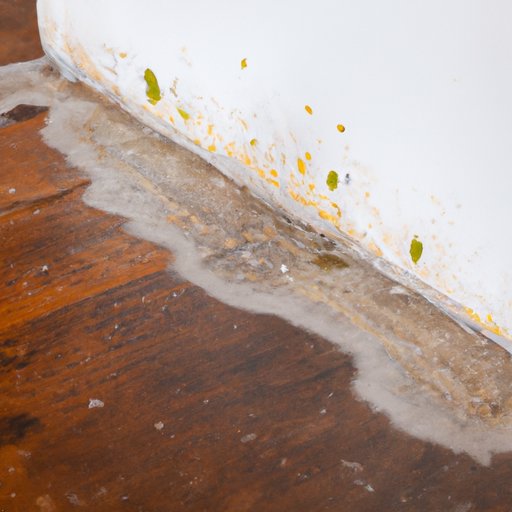
Introduction:
Mold growth is a common problem in many homes and can be harmful to health if not addressed. Mold reproduces by releasing spores into the air, which can cause allergies, respiratory problems, and other health issues. This article offers a comprehensive guide on how to detect, prevent, and get rid of mold in your home.
Practical Guide: How to Detect, Prevent, and Get Rid of Mold in Your Home
There are several types of mold, and they can differ in color, texture, and pattern. Some molds are harmless, while others can pose serious health risks. It is essential to detect mold growth early to prevent it from spreading. Common signs of mold growth include a musty smell and discoloration of surfaces.
To prevent mold from growing in your home, you should keep it well-ventilated and humidity-free. Mold thrives in moist environments, so eliminating any sources of moisture is crucial. This can be achieved by fixing leaks, drying wet areas, and using dehumidifiers.
When getting rid of mold, it is essential to wear protective gear such as gloves, masks, and goggles to avoid inhaling the spores. You can remove mold from non-porous surfaces such as tiles, glass, and metal by using a solution of water and detergent. For porous surfaces such as drywall and carpets, it may be best to replace them entirely to ensure complete removal.
Natural Remedies to Prevent and Eliminate Mold
Natural remedies are an effective and safe way to prevent and eliminate mold growth in your home. Vinegar is a common natural remedy that can kill up to 82% of mold species. To use vinegar, mix it with equal parts of water and spray the affected area. Leave it on for an hour, then rinse off with water.
Tea tree oil is another natural mold inhibitor that can be used by adding a teaspoon of it to a cup of water and spraying it on the affected area. Baking soda can also be used to eliminate mold by mixing it with water to form a paste and applying it to the affected area. Leave it on for a few hours, then scrub with a brush and rinse off with water.
Hydrogen peroxide is a powerful disinfectant that can kill mold spores on contact. To use hydrogen peroxide, spray it on the affected area and leave it on for at least 10 minutes, then scrub with a brush and rinse off with water.
Expert Advice on Mold Remediation and Water Damage
We talked to experts in mold remediation and water damage repair, and they recommend hiring a professional mold remediator if the mold covers an area larger than ten square feet or if there is a previous history of water damage in your home.
Experts suggest that prevention is key and that homeowners should keep their homes well-maintained, fix leaks immediately, and keep humidity levels below 60%. In addition, they recommend keeping air conditioning systems, ducts, and filters clean to prevent mold from spreading.
When it comes to mold removal, experts recommend following industry-standard guidelines to ensure a safe and effective process. This includes using protective equipment, isolating the affected area, and fixing any sources of moisture to prevent mold from returning.
Frequently Asked Questions (FAQs) About Mold in the House
Some common questions about mold growth in homes include: why does mold occur, how does it spread, and how can it be prevented, among others. Mold occurs due to moisture, warmth, and organic matter, which creates an ideal environment for mold growth.
Mold spreads by releasing spores into the air, which can attach to surfaces and grow if the conditions are favorable. To prevent mold growth, you should keep your home dry and well-ventilated, fix any leaks immediately, and use dehumidifiers when necessary.
If mold has already been removed, it is crucial to fix the source of moisture to prevent it from coming back. The speed at which mold spreads can depend on factors such as humidity, temperature, and air movement.
DIY Mold Removal: Step-by-Step Guide
When removing mold from your home, it is crucial to take necessary safety precautions such as wearing protective gear. The tools you will need for the job include gloves, masks, goggles, a bucket, and a scrub brush.
The cleaning agents you can use include bleach, vinegar, hydrogen peroxide, baking soda, and tea tree oil. For non-porous surfaces, use a solution of water and detergent or a bleach solution to clean the affected area. For porous surfaces, it may be best to replace the affected material entirely.
Finally, taking preventive measures is important to avoid mold growth in the future. You can do this by keeping your home well-ventilated, fixing leaks immediately, and using dehumidifiers when necessary.
Conclusion
Mold growth in the home can cause health problems, damage your property, and reduce indoor air quality. It is essential to take quick action to prevent, detect, and remove mold from your home. Natural remedies and DIY methods can be used to eliminate mold, but larger infestations require professional attention.
By taking preventive measures and following industry standards for mold remediation, you can ensure a safe and healthy home that is free of mold growth.




